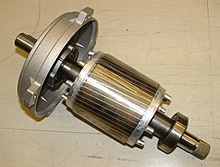Squirrel-cage rotor: Difference between revisions
m →Theory |
|||
| Line 9: | Line 9: | ||
The solid core of the rotor is built with stacks of electrical steel laminations. Figure 3 shows one of many laminations used. |
The solid core of the rotor is built with stacks of electrical steel laminations. Figure 3 shows one of many laminations used. |
||
The rotor has a smaller number of slots than the [[stator]] and must be a non- |
The rotor has a smaller number of slots than the [[stator]] and must be a non-integer multiple of stator slots so as to prevent magnetic interlocking of rotor and stator teeth at the starting instant.<ref>theory and performance of electrical machines, J.B.Gupta</ref> |
||
== Theory == |
== Theory == |
||
Revision as of 19:20, 1 April 2014
This article relies largely or entirely on a single source. (January 2013) |

A squirrel-cage rotor is the rotating part (rotor) used in the most common form of AC induction motor. It consists of a cylinder of steel with aluminum or copper conductors embedded in its surface. An electric motor with a squirrel-cage rotor is termed a squirrel-cage motor.
Structure

In overall shape, it is a cylinder mounted on a shaft. Internally it contains longitudinal conductive bars (usually made of aluminum or copper) set into grooves and connected at both ends by shorting rings forming a cage-like shape. The name is derived from the similarity between this rings-and-bars winding and a squirrel cage.
The solid core of the rotor is built with stacks of electrical steel laminations. Figure 3 shows one of many laminations used. The rotor has a smaller number of slots than the stator and must be a non-integer multiple of stator slots so as to prevent magnetic interlocking of rotor and stator teeth at the starting instant.[1]
Theory

The field windings in the stator of an induction motor set up a rotating magnetic field through the rotor. The relative motion between this field and the rotor induces electric current in the conductive bars. In turn these currents lengthwise in the conductors react with the magnetic field of the motor to produce force acting at a tangent orthogonal to the rotor, resulting in torque to turn the shaft. In effect the rotor is carried around with the magnetic field but at a slightly slower rate of rotation. The difference in speed is called slip and increases with load.
The conductors are often skewed slightly along the length of the rotor to reduce noise and smooth out torque fluctuations that might result at some speeds due to interactions with the pole pieces of the stator. The number of bars on the squirrel cage determines to what extent the induced currents are fed back to the stator coils and hence the current through them. The constructions that offer the least feedback employ prime numbers of bars.
The iron core serves to carry the magnetic field through the rotor conductors. Because the magnetic field in the rotor is alternating with time, the core uses construction similar to a transformer core to reduce core energy losses. It is made of thin laminations, separated by varnish insulation, to reduce eddy currents circulating in the core. The material is a low carbon but high silicon iron with several times the resistivity of pure iron, further reducing eddy-current loss, and low coercivity to reduce hysteresis loss.
The same basic design is used for both single-phase and three-phase motors over a wide range of sizes. Rotors for three-phase will have variations in the depth and shape of bars to suit the design classification. Generally, thick bars have good torque and are efficient at low slip, since they present lower resistance to the EMF. As the slip increases, skin effect starts to reduce the effective depth and increases the resistance, resulting in reduced efficiency but still maintaining torque.
Practical demonstration
To demonstrate how the cage rotor works, the stator of a single-phase motor and a copper pipe (as rotor) may be used. If adequate AC power is applied to the stator, an alternating magnetic field revolves around the stator. If the copper pipe is inserted inside the stator, there will be an induced current in the pipe, and this current produces another magnetic field. The interaction of the stator revolving field and motor induced field produce a torque and thus rotation.
Use in synchronous motors
Synchronous motors may employ a squirrel cage winding embedded in their rotor to allow them to reach near-synchronous speed while starting. However the rotor is different in shape and material, because at synchronous speed it is designed to magnetize and become a permanent magnet. Once operating at synchronous speed, the magnetic field is rotating at the same speed as the rotor, so no current will be induced into the squirrel cage windings and they will have no further effect on the operation of the synchronous motor in steady state operation.
Induction generators
Three phase squirrel cage induction motors can also be used as generators. For this to work the motor must either be connected to a grid supply or an arrangement of capacitors. If the motor is run as a self exciting induction generator (SEIG) the capacitors can either be connected in a delta or c2c[clarification needed] arrangement. The c2c method is for producing a single phase output and the delta method is for a three phase output. For the motor to work as a generator instead of a motor the rotor must be spun just faster than its nameplate speed, this will cause the motor to generate power after building up its residual magnetism.
References
- ^ theory and performance of electrical machines, J.B.Gupta
